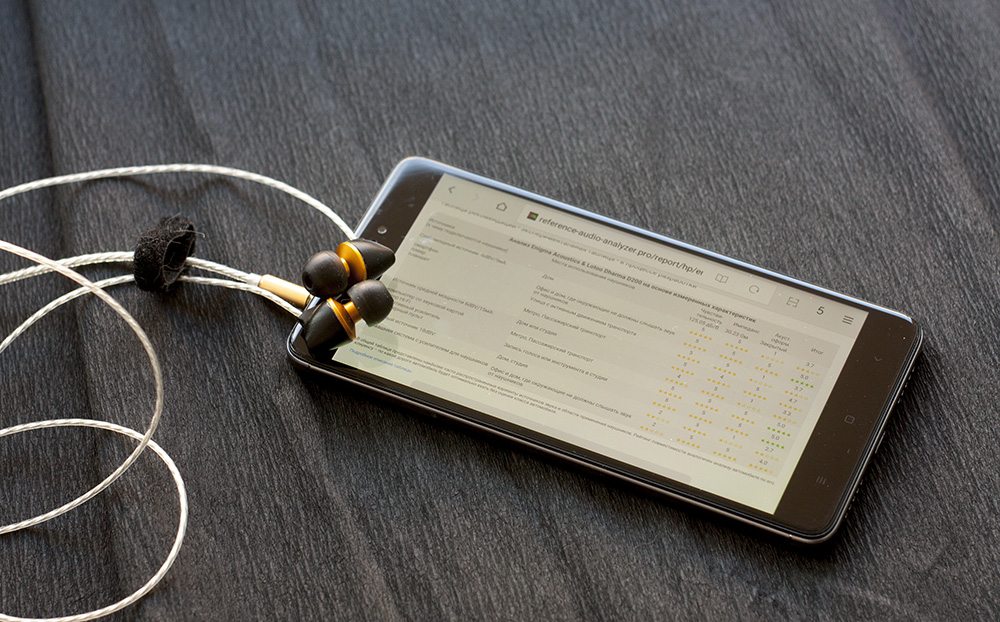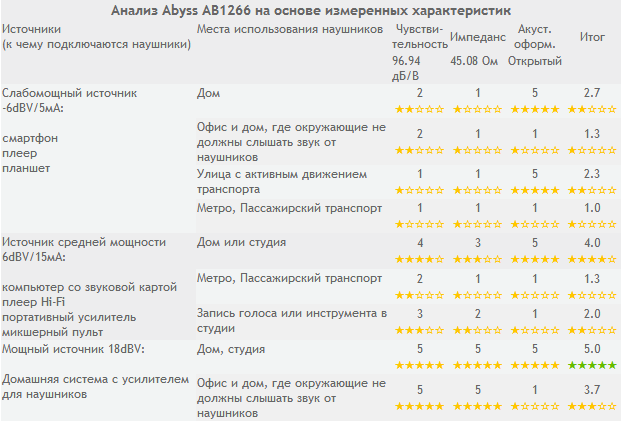The RAA has developed a table of recommendations on the compatibility of headphones and sources (smartphones, players, tablets, sound cards, etc.) based on measured characteristics.
Compatibility rating is similar to the analysis of the car on its ground clearance - on which road the car will optimally go without assessing the class of the car. For example, a racing car of Formula 1 is difficult to get to the cottage on a dirt road, and on a caterpillar all-terrain vehicle is stupid to drive on a high-speed highway. Similar compatibility is implemented for headphones.

Background to the development of the recommendation table
Reference Audio Analyzer is a domestic laboratory for measuring audio products. More than 700 measurement reports of various products are posted on the project website: headphones, music players, amplifiers, sound cards and other devices.

The project started in 2008, the main goal of which was to get more data through automated testing, which did not allow making alternative software. Now a report with a large number of graphs is created for each product, and the testing itself does not take too much time. In order to benefit from testing was not only for professionals, but also for ordinary consumers, the project also works to improve data for ordinary users. This is not only a separate FAQ section and annotations next to the charts, but also preparation for dividing reports into “professional” and “dummies” views.

Due to the emphasis on optimal compatibility of specific models of headphones and sources (amplifiers, smartphones, players, etc.), the idea arose to present a table of optimal combinations for headphones and amplifiers based on their characteristics. And in the table are banal "stars" rating. By and large, it is the stars that interest the average user, and not the intricate numbers.

About headphone and amp settings
Headphones have parameters such as their sensitivity, impedance and type of acoustic design. In amplifiers - their output power in the form of the dependence of the maximum voltage level on the resistance value of the headphones. In addition to all this, the headphones are heard at different volumes depending on the surrounding conditions.
The headphone sensitivity parameter allows you to calculate how much voltage the amplifier should apply to the headphones in order to obtain the calculated sound pressure.
Thus, it is possible to make a preliminary calculation of compatibility, whether there will be a sufficient amplifier for specific headphones in a certain situation.
This compatibility rating is similar to the analysis of the car on its ground clearance - on what road the car will optimally go without assessing the class of the car. On a Formula 1 racing car, it is difficult to get to the cottage on a dirt road, and on a caterpillar all-terrain vehicle, it’s foolish to take the expressway. This is not a search for the nuances of sounding between a silver and a gold cable - this is the most primary selection. If you skip this stage of selection, then a bunch of expensive and high-end headphones and an amplifier can play worse than outright trash. Try to drive in the Moscow metro to Abyss AB1266 with a HiFiMan HM901 player with an IEM amplifier. It will be worse than an ordinary smartphone with cheap plugs.
The table allows you to estimate the most complete disclosure of the potential of headphones when used in conjunction with devices of a similar class, but with different power parameters.
One of the snags is that measurement data is given to a sine, not a musical signal.
The music signal, in turn, is variable in volume. For this, the correction between the “sine” and the musical signal was calculated. A comfortable volume was set in the headphones, where the sound level meter showed sound pressure in the range of 85-90 dB SPL when playing a music signal. If you do not touch the volume control and run the sine, the sound pressure becomes 110 dB. Thus, an amendment in the form of 20 dB between the "sine" and "music" was obtained. Music for the evaluation was used pop-dance genres, as the most typical and loud.
If we want to listen to music at 90 dB SPL, the amplifier must be set to a voltage that would provide 110 dB SPL for the sine.Depending on the noisy environment, the recommended listening level will vary. If the situation is noisy - the volume in the headphones should likewise be higher. At the same time, in closed-type headphones, external noise will be quieter and, accordingly, the volume should be set lower.
In some conditions, headphone noise isolation is mandatory, while in others it is contraindicated. For example, when recording an instrument or vocal on a microphone, the “minus” from the headphones should not fall into the microphone. In a noisy transport without sound insulation, you have to greatly increase the volume of music playback and not only to plant a hearing, but also to annoy the surrounding passengers. But with cyclocross to the music, on the contrary, open-type headphones without noise insulation are needed to hear the surrounding transport.
Now, based on the technical data of the headphones, you can find out whether the selected amplifier is suitable for them.
Typical source amplifiers
In an amplifier, the basic data is the maximum voltage and current in the specified quality criteria. In the RAA, such criteria are non-abstract numerical coefficients. distortion, and the modes of operation of the amplifier, equivalent to the classes A, AB, B, and on the verge of clipping. After analyzing a large number of amplifiers, the maximum values for weak, medium and powerful amplifiers with respect to class A were determined for the table.
- For a weak amplifier in the form of a smartphone, tablet and player, the maximum level of –6 dBV and 5 mA was taken.
- For an average power source (computer with sound card, Hi-Fi player, portable amplifier or mixing console): 6dBV / 15mA
- And as a powerful amplifier, a maximum level of 18 dBV was taken without any limit on the current level.
Voltage levels are expressed in dBV and not volts due to the fact that these data are intended for use by ordinary consumers, and not by engineers. For example, in the professional sphere, where a large number of devices are switched (instruments, mixers, preamplifiers, equalizers and other sound processing devices) all absolute levels are expressed in decibels dBV and dBu, and relative simply in dB.
Calculation algorithm
The calculation of estimates is based on the following algorithm:
First, the optimum volume level is specified taking into account the noise of the surroundings and the presence of noise insulation of headphones.
The optimum volume level is determined for ideal conditions when there is no external noise. In reality, the situation is different and is adjusted for each specific situation.
If the headphones with noise insulation, the level is reduced by 6 dB, and with partial noise isolation by 3 dB.
The environment is estimated by a factor from 0 to 2. Next, it is added to the optimal level through multiplication coefficients. by 6 dB.
Optimal = SPLOptimal + Environment • 6 - Noise cancellation
Where
• SPLOptimal = optimum datum level 110 dB SPL
• Environment - environment noise ratio
• Noise cancellation - headphone noise reduction correction
Having obtained the value of the optimal level in dB SPL, we make an assessment of the source's capabilities, based on its power parameters.
Headphone sensitivity analysis
We can have two poor compatibility options: the source is quiet or too loud.
The source is quiet
 The source is quiet and cannot provide the required volume level with specific headphones.
The source is quiet and cannot provide the required volume level with specific headphones.We calculate the difference in dB between the capabilities of the source and the optimal level.
Delta = Sensitivity + Amp Voltage - Optimal
Where
• Sensitivity - headphone voltage sensitivity
• Amp Voltage - the maximum voltage level in dBV
• Optimal - the optimal required level, calculated earlier
Rating = 5 + [Delta / 6]
Source is loud

Many modern devices use digital volume control and when setting a small level the background noise at the output does not decrease and becomes noticeable against the background of the music being played. Devices with an analog regulator often have an imbalance in volume between the right and left channels due to the imperfection of typical variable resistors, which controls the volume level.
If the previously received Delta is positive and not more than 20 dB, then score 5 on a five-point scale. Over 20 dB, the score is reduced by one for every 6 dB.
Score = 5 - [(Delta - 20) / 6]
Headphone impedance parameter analysis
When analyzing the resistance, we similarly determine the optimal level of Optimal and estimate the source by the maximum current, without voltage. If there is a stock of current, then score 5 on a five-point scale. If the current is not enough, the estimate is reduced. In those cases when there is not enough current level, the sound of the source becomes lower quality.
First, consider the required voltage level at the source
VdBV = Optimal - Sensitivity
Where
• Sensitivity - headphone voltage sensitivity
• Optimal - the optimal required level, calculated earlier
We translate the voltage from dBV to V and count the current.
IOptimal = 1000 • V / R
Where
• R - Ohm resistance
• V Voltage Volts
Compare current with the maximum for the source in dB.
Delta_I = 20 • Log10 (ISours / IOptimal)
By analogy with the voltage, we calculate the estimate, where a decrease of 6 dB takes one
Rating = 5 - [Delta / 6]
Sound insulation rating
Evaluation of noise insulation is set from external conditions, need insulation or not. For example, for a cyclist on the street among the cars noise isolation is contraindicated. In the metro in a noisy environment noise isolation is required.
• If the headphones have noise isolation and it is needed, then a rating of 5.
• If there is noise insulation and it is not needed or vice versa there is no noise insulation and it is needed, then score 1.
• Headphone with partial noise isolation rating 3.
The final score is the arithmetic average of the three estimates.
Total

Thus, you can quickly navigate where the specific headphones would be best. But most importantly, the assessment is completely impartial, it depends only on the measured parameters in the same conditions and does not affect the seller’s margin.
Comments welcome suggestions and comments on this method of calculation.
Further development
A little later, an “online calculator” will be opened, where you can manually enter data from the headphones and the amplifier and receive a recommendation for their use. Additional parameters will be added in the form of “I listen to music quietly,” “noise insulation needs partial,” etc. under individual cases.
In the future, a similar table will appear for sources-amplifiers with the possibility of on-line selection of specific headphones instead of generalized typical averaged models.
→
RAA Project→
RAA Headphone Measurement Report Database→
Table of recommendations with an example of calculation (for those who did not understand the formulas)